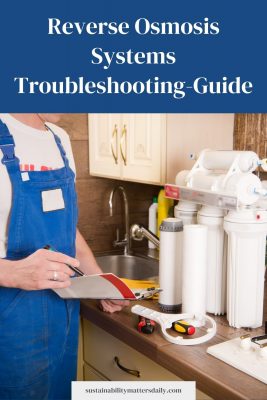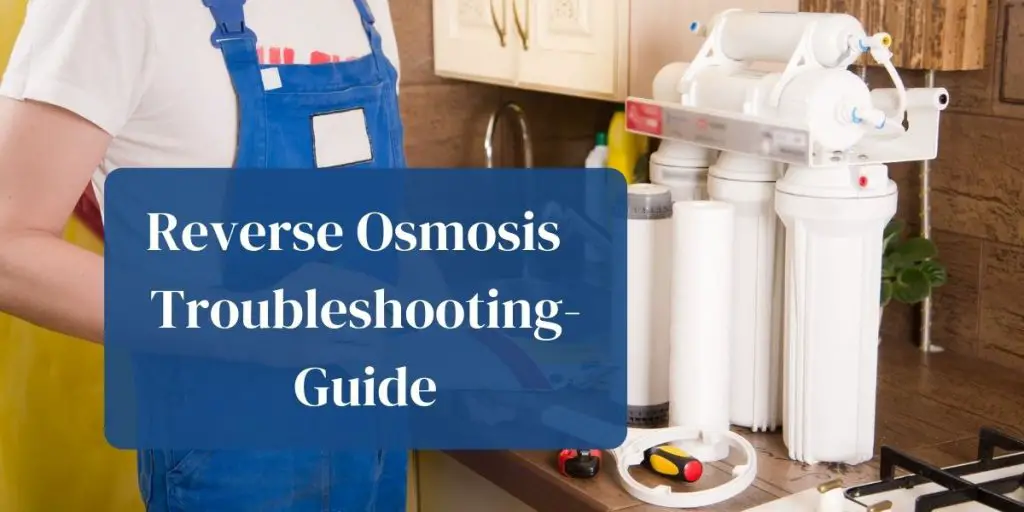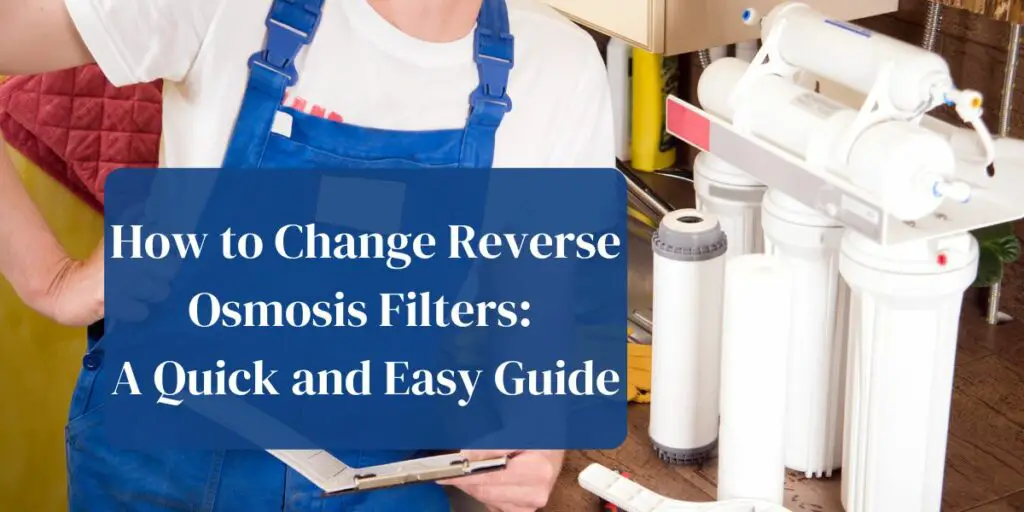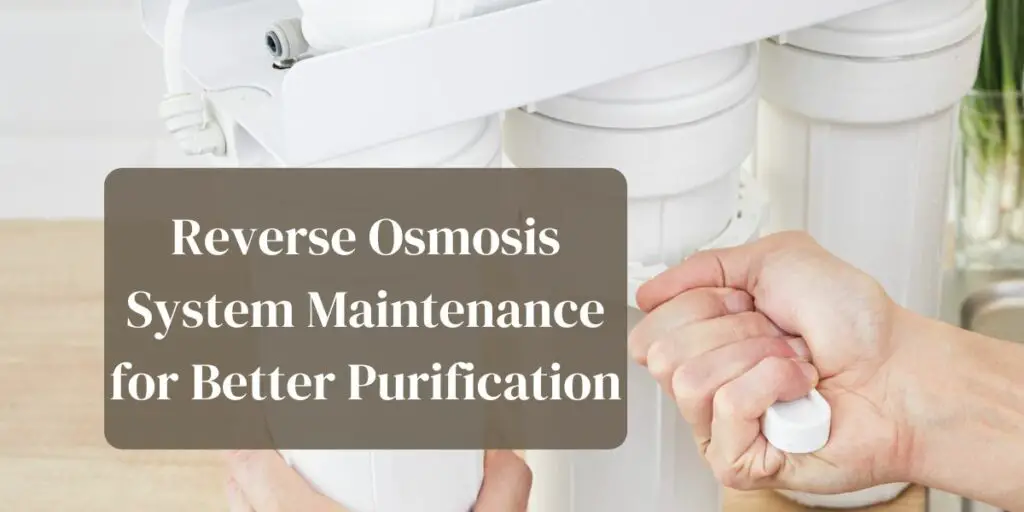Reverse osmosis systems are known for their unique ability to provide families with pure water. They are also known for the many problems they tend to have once they have been installed.
Is it constantly draining? Or is no water coming out? Are filters or valves not working?
Please note any problem you run into should be resolved as soon as possible. Ignoring an issue could only lead to bigger issues later on down the road.
To avoid panic and prevent you from making frantic calls, we familiarize you with some problems you are likely to encounter with your Reverse Osmosis system and their probable causes.
With that being said, here are the most common reverse osmosis problems you will run into and how to troubleshoot them.

Table of Contents
- Troubleshooting Guide: Reverse Osmosis Problems and Solution
- 1. Noisy drain or faucet
- 2. Water flow is slow
- 3. The reverse osmosis system constantly drains
- 4. Dripping or leaking faucet
- 5. Bad taste and odors in the water
- 6. Air gap faucet is leaking
- Conclusion
Troubleshooting Guide: Reverse Osmosis Problems and Solution
Here are the 10 most common issues:
1. Noisy drain or faucet
What are common causes for noisy drains or faucets?
- low pressure
- damaged bladder
- storage tank pressure too high
- feed water pressure too low
- poor membrane
- clogged filters
- bent tubing
- empty storage tank
- closed valves
If you are using your reverse osmosis system for the first time, or you have recently had some filter cartridges replaced, there is a good chance the drain line will make a little noise.
This happens when air is being pushed out of the system. For the most part this is nothing to worry about.
However, if the noise continues after a day or two you may want to have a look around the system to make sure everything is properly hooked up.
Start by checking the tubing and making sure it is set straight. Look for any restrictions in the drain tube that could be interrupting the flow of water.
If you find that the system is still noisy, you may need to check the entire system for gaps. If there are any faults, be sure to have them corrected as soon as possible.
2. Water flow is slow
Have you had your reverse osmosis system installed for a few years now? Have you enjoyed waking up every morning to a nice refreshing glass of water?
If so you would probably be devastated if you woke up one morning to find your beloved reverse osmosis system has a very slow water flow. In some cases, there may be no water flow at all.
If you have little to no water flow, it is usually the result of one of two things. Either the water pressure is low or the volume of water is low.
Reason: Malfunctioned water tank
This type of problem is usually caused by a storage tank that has malfunctioned. The storage tank has an air bladder that increases the pressure when more water starts to flow into the tank.
If the bladder malfunctions due to a leak or break, it won’t be able to build up enough pressure in the tank. As a result, you will experience slow or no water flow.
To solve this problem, you will first need to check the tank to see if it’s full. If the tank is full, it will weigh around 20 pounds (ca. 9 kg). If the tank is empty, it will weigh less than 2 pounds (0.91 kg).
If the tank is full, that usually means the problem is coming from the inside. To fix it, you will need to pressurize your reverse osmosis tank.
Here is how to do it?
Step 1: Start by shutting off the cold water supply to the system.
Step 2: Make sure the storage tank valve is closed.
Step 3: Disconnect the tank and take it outside. Once outside, you will need to open the tank valve and drain out all the water.
When you first open the valve the water will start to pour out quickly. However, after a few minutes it will start to slow down and eventually become nothing more than a trickle.
Step 4: Don’t be fooled by the trickle of water. There will still be quite a bit of water left inside the tank.
To get it out, you will need to use a bicycle pump or a compressor to pump air into the pressure vessel. Every time you pump you will notice more water pouring from the tank.
Step 5: Once all the water has been removed from the tank, you will need to measure the pressure inside using a pressure gauge.
The gauge should read between 6 psi and 8 psi. If the pressure falls below that, you will need to pressurize it again.
Step 6: Once you are done pressurizing the tank, you can reconnect it to the reverse osmosis system. Once reconnected, refill the system by opening the tank valve and the feed water valve.
If after a few days you notice the water pressure falls again, this would mean the air bladder is malfunctioning and the whole tank will need to be replaced.
Reason: The reverse osmosis membrane is clogged
Slow water flow may also be a sign that the low feed water pressure is too low. This is usually caused by your reverse osmosis membrane going bad because of clogged filters.
When the membrane is constantly being forced to process water that is exceptionally hard, this will lead to it becoming clogged up.
To fix this issue, you can either replace the membrane more often or you can install a water softener to help remove certain minerals from the water before it goes through the filtration system.
If the low water flow is being caused by clogged filters then you will need to have them replaced as well.
Clogged filters tend to be more common in new homes where high levels of debris and sediment temporarily fill the plumbing system.
Reason: Bent tubing
Slow water flow can also be a result of bent tubing. When tubing is bent the pressure in the tank gets reduced and the flow of water gets restricted.
Check the tubing and if any water lines are bent, straighten them out immediately.
Reason: Low feed water pressure
The feed water pressure can also affect the flow of water. If the feed water pressure is 40 psi or lower, you should use a pressure pump to increase the pressure to the right level.
3. The reverse osmosis system constantly drains
Common reason for draining system are:
- Storage tank pressure too low
- tank air bladder damaged
- broken shut-off valve
- broken check valve
- feed water pressure low
- incorrect installation
- degraded membrane
- worn out flow restrictor
All reverse osmosis systems, including whole house reverse osmosis systems, work on pressure. Anytime the storage tank is full and there is full pressure, the automatic shut off valve gets automatically triggered.
Once this happens, water stops flowing into the system and rejected water stops flowing down the drain line.
Reason: Valves are not working properly
If the shut-off valve or check valve are not functioning properly water will continue to flow down the drain line. As a result, your reverse osmosis system will constantly drain, waste a ton of water, and make a lot of noise.
Check the pressure in the tank
To fix this issue there are two potential tests you will need to run. But first you will need to measure the pressure in the tank using a pressure gauge.
Make sure the tank is full before you try to measure the pressure. You will know its full when you try to lift it.
The pressure inside the tank should be between 35-40 psi. If the pressure falls within this range then that means either the shut off valve or the check valve need to be replaced.
Here are the two tests you can perform to see if the valves need to be replaced:
Valve Check #1
This test will help you determine if the automatic shut off valve and check valve are functioning properly.
- Lower the pressure in the tank by letting about 20 oz (0.76 kg) of water flow from the faucet. This will force the system to start processing water to refill the tank.
- Mimic a full tank by closing the tank valve.
- Give the system 5 minutes to process the water.
- The fourth and final step is to check to see if the water has stopped flowing down the drain line.
You can do this by listening to what the system is doing, or by removing the drain line from the drain saddle.
If the water has stopped flowing that means the valves are functioning as they were designed to do so. If on the other hand the water continues flowing down the drain, this means one of the valves is broken.
If the valves are broken continue on to the second test.
Valve Check #2
- Keep the tank valve open while the tank is refilling.
- Turn off the feed water valve.
- Check to see if water is still flowing down the drain line. Refer back to step 4 in the previous test to see how this is done.
If water is still flowing, it means it’s coming from the storage tank. This indicates the check valve is broken and needs to be replaced.
If no water is flowing, that means the automatic shut off valve is no longer functioning properly and will need to be replaced.
Here’s a video guide on troubleshooting draining RO systems:
When you find out the valves don’t do their job, you need to replace them.
Broken valves are the main reasons for draining water, but there might be others, too:
Reason: Improper installation
Did you hire a professional installer, or did you try to install the system yourself? Improper installation is one of the biggest reasons water will continue running down the drain.
While we always recommend hiring a professional, we realize that’s not always feasible. If you intend to install it yourself, make sure you take your time and carefully read through all instructions.
Make sure all system parts are in the right position before operating the system.
Reason: Worn down flow restrictor
Over time, the flow restrictor can wear down and cause the system to continue to run on a constant basis. To fix this issue, simply replace the flow restrictor.
4. Dripping or leaking faucet
Have you noticed your faucet is dripping or leaking for no apparent reason? If so, this may be a sign that some system parts aren’t fitted properly.
Stopping the dripping and leaking is as simple as inspecting the machine and making sure all fittings are tightened.
Check the tubing to make sure it is pushed all the way into the ports, valves and drain saddle.
If you notice the leaking is coming from the bottom of the faucet stem, the only way to fix this is by replacing the piece.
5. Bad taste and odors in the water
There is nothing worse than wanting a glass of cold water only to find the taste and odor are very unpleasant.
And while the purpose of a reverse osmosis system is to provide you and your family with pure drinking water, it’s not uncommon for this type of system to add a strange taste or odor to the water.
Unfortunately, there is only one way to prevent this from happening, and that is to be willing to invest in a good reverse osmosis system.
Reason: Degraded membrane
After using the system for several years, it is very common for filtered water to start turning a bit cloudy. The most common cause for bad tastes or odors in the water is a degraded membrane.
Cloudy water is usually a result of biofilm accumulating in the various stages of filtration. The only way to get rid of biofilm is to immediately replace all clogged filters and any membranes that are fouled.
Once you have replaced the filters and the membranes, make it a point to continue replacing them every 6 to 12 months.
By replacing these components regularly, you can prevent germs from accumulating in the reverse osmosis system.
To prevent germs from accumulating in both the filter unit and the water flowing through it, consider investing in a system that allows you to dispose of both the filter and the filter housing at the same time.
Please note, these type systems are usually more expensive than regular systems. The maintenance costs will also be a little higher.
However, the extra cost will be well worth it, being that you won’t have to worry about germs getting into your drinking water and causing potential health issues.
To extend the life of your unit and keep your family safe, we recommend doing maintenance on the system a minimum of twice a year.
Make sure you clean it exactly as the manufacturer’s instructions tell you to.
Reason: Stagnant water in the tank
Another source of bad tasting or smelling water is unused water. If water is stagnant for an extended period of time, bacteria will start to grow. Anytime bacteria start to grow, that can affect the taste and smell of the water.
If your reverse osmosis system has been sitting idle for a while, take the time to flush the entire system, including the storage tank, two times before using it again.
This will ensure anything that has built up in the filters and tank will get flushed out.
6. Air gap faucet is leaking
Common causes for leaking air gap faucets are:
- Loose connection
- damaged faucet stem
- drain line clogged
- drain saddle shifted
Have you noticed water coming out of the hole of the air gap faucet? If so, this is known as an air gap leak, and it is effortless to fix.
An air gap leak happens when the drain line becomes blocked with debris that has accumulated in the drain.
The purpose of the air gap is to prevent drain water from flowing back into the reverse osmosis system.
During normal operation, the water will flow from the storage tank up to the faucet. The water will then fall through a small pocket known as the “air gap“.
If the drain line starts to clog, it will create back pressure. This back pressure will push the water through the faucet, and it will get all over the sink.
While this may sound bad, fixing it is not as difficult as you may think. All you have to do is clear out the drain line so that water is no longer restricted and able to flow freely again.
This can be done using either a wire brush or a pipe cleaner. The end connected to the drain saddle is the end you want to clean.
You should also clean the drain saddle as stuff tends to grow inside it as well.
Drain saddles are also known to shift during operation. If the saddle shifts, that too can restrict the flow of water.
After you have cleaned the drain line, take a few seconds to check the drain saddle. If it has shifted, realign it so that the drain saddle is in line with the drain line hole.
Here’s a video instruction on how to fix leaking air gap faucets:
Preventing an air gap leak
While it’s impossible to eliminate the chances of an air gap leak happening, there are a few things you can do to ensure they don’t happen regularly.
The air gap faucet is connected to your kitchen sink drain. When the train is clogged, the backwater flows out the hole in the faucet – that’s what it is made for.
The first thing you can do is avoid throwing big chunks of food down the drain. This is probably one of the leading causes of clogged drains.
Instead of throwing food down the drain, put it in a small bag or wrap it in waste paper and throw it into the waste bin. This extra step can prevent many issues eventually.
The second thing you should do is treat your drain line regularly. All you need to do is pour a little natural cleaner down the drain, and you will be good to go.
Bio-Clean Drain Septic 2#
Can clean drains, septic tanks, and grease traps: All natural and 100% guaranteed no caustic chemicals! Removes fats, oil, and grease; completely cleans your system.
Check the price on AmazonDoing so will help dissolve any potential blockades before they become a serious problem.
Conclusion
And there you have it, ten of the most common issues you will run into when using a reverse osmosis system.
When it boils down to it, most of these issues can be avoided by doing maintenance on the system once or twice a year.
Doing regular maintenance will not only ensure your reverse osmosis is always running smoothly, but it will also save you money as you will be less likely to have to deal with a serious problem.
Investing in a good system is also important. The best systems don’t break down as easily as systems that aren’t made using quality parts.
Just because you’re on a budget does not mean you can’t afford a decent reverse osmosis system. The key is to do plenty of research to make sure it is manufactured by a reputable company. Or RO Systems reviews may help you to shop a quality system.
You are sure to find a system that not only fits your budget, but that also has most of the features you desire.
More info on reverse osmosis systems maintenance:




I never run out of water is something hooked up wrong
Dr. Sr
I have a 2 reverse osmosis machine, they 20 m3/h and 40 m3/h permeate water production independently. They are get a sources of water from one place. The process flow for those system are as follows :- Borewell water (from two different wells one 65oc & 33 oC, The one higher pressure is passing through Plate heat exchanger and both are store in one tank) – Feed Pumps ( Each pumps 56m3/h)- Disc Filter – Ion Exchanger- Multimedia Filter- safety Filter ( Bag Filter & Cartage Filter) – Revers osmosis ( On the machine before the membrane it has own Cartridges’ filter 1& 0.5 Micron). Now the problem is both RO machines is not working together with full capacity & one of the RO machine is displayed ” LOW feed Pressure” .
Can’t find on-line any troubleshooting for issue, when reverse osmosis bust pump keeps running, without flows water to drain.
Could you explain what to do in this case?
I mean ‘booster pump’, my phone replaced to ‘bust pump’ ))